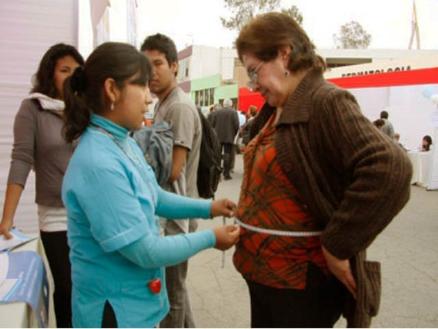A Weight Problem II

“My gordita!” was a term of endearment, yet the idea of being fat has changed from being endearing to being less desirable. More and more people are facing life threatening illnesses because of obesity.
What was driving these changes? Aren’t people just as likely to eat healthy foods as they were in previous generations? What has changed?

The number of visual cues we are exposed to has evolved into an art and a science. ‘Food Porn’ is thrust upon us with increasing constancy. From television ads to magazine advertisements, to pop ups on the internet and cell phones, there are representations of beautiful, desirable food. According to Charles Spence et al, there are some very real correlations between visual stimuli and overeating. It was Apicius, the 1st Century Roman gourmand who purportedly coined the phrase “We eat first with our eyes”.
We have evolved a highly developed sensory system based on visual cues from the environment. The situation of the mouth near the brain is no condescendence, according to Spence and he concludes “ Given the essential role that food plays in helping us to live long and healthy lives, one of the key challenges concerns the extent to which our food-seeking sensory systems/biology, which evolved in pre-technological and food-scarce environments, are capable of adapting to a rapidly-changing (sometimes abundant) food landscape, in which technology plays a crucial role in informing our (conscious and automatic) decisions.
Visual cues may have changed, but don’t people still eat the same foods as they have in previous generations?

A key factor in Peru is the improvement of the economic status of many people. “Less than 30 percent of Peruvians live below the poverty line, down from about 60 percent a decade ago, and economic growth has been well above the regional average”.
This change in the welfare of the people has provided opportunities for many more Peruvians to purchase goods that they could not formerly afford. Peru’s unprecedented economic growth — approximately 7% annually over recent years — has facilitated the emergence of a robust middle class with increasing disposable income. According to the Inter-American Development Bank (IADB), “the percentage of Peruvians considered “middle class” doubled to 70% of the population between 2005 and 2011.” http://knowledge.wharton.upenn.edu/article/real-estate-credit-emerging-middle-class-peru/. These real changes in economy have allowed more people to make choices about the foods they consume.
In a longitudinal study conducted by James Fisher of the University of Massachusetts, the availability of food in Ñuñoa, Peru was examined over a period of time from 1967 to 2015.
Fisher’s “Study results show clearly that the amount and diversity of new foods available in the area has increased dramatically, but also gives evidence for continued disparate access to certain types of food along class lines” and “Socioeconomic status had a significant negative correlation with food insecurity and poor households more frequently consumed both potatoes and other cheap, high carbohydrate foods such as rice, noodles, and flour. In contrast, foods eaten significantly more often by wealthier households included cheese, fish, and vegetables, all of which have become much more available since dietary surveys were conducted in the late 1960s”
While many households have a greater ability to purchase food they want, many others still go hungry. In this graph from Estado Nutricional en el Perú por etapas de vida; 2012-2013, published in 2015, the disparity of income between urban dweller and those who live in rural areas is marked. While there have been some declines (37% to 34%) in rural malnutrition, there are marked differences in food security between urban and rural households.
However, as demonstrated by Fisher’s work in Ñuñoa, foods that have become available to the poor are not always nutritious. He noted a change in diet, with a decrease of use of chuño and other crops grown locally to a growing dependence upon outside, processed foods. There are now over 100 tiendas in this small town, and more people report eating their meals from food vendors and restaurants. He says, “There are two types of restaurants: pensiones sell fixed menu lunches and dinners and cater especially to wage workers in town. Regular customers can keep tabs to be settled at the end of the month. Pollerias are restaurants that only sell pollo a la brasa (rotisserie chicken and French fries), a dish popularized in Lima in the 1950s. Hot meals are also available from street vendors which begin to gather in the center of town at dusk. Fried chicken, noodles, and popcorn are commonly available. Throughout the rest of the day mobile carts carry fruit and packaged snacks such as 15 candy bars, potato chips and soda and position themselves on busy street corners, or near large events such as weddings. When schools let students out for lunch and recess food carts gather in the school yard to sell them sandwiches and other lunch items.”
The changing market place has many more prepared foods. Some of these, like potato chips or soda are known detriments to health. Other products are marketed as healthy, and may be, but their importance in the traditional diet is changed. Drinking milk is touted by a local company as having the ability to increase height. Three glasses of day are recommended.
This is in contrast to the traditional that included milk infrequently, and in fact, milk was not reported at all in the 1967 survey of Ñuñoa. Now the farmers have banded together to raise dairy herds and the large wheels of cheese are visible in the pizzerias and tiendas of Cusco.
The evolving technological environment, the challenges of economic and political change as well as the pressures of commercialism on the food landscape are creating environment that increases the prevalence of overweight and obese populations.




